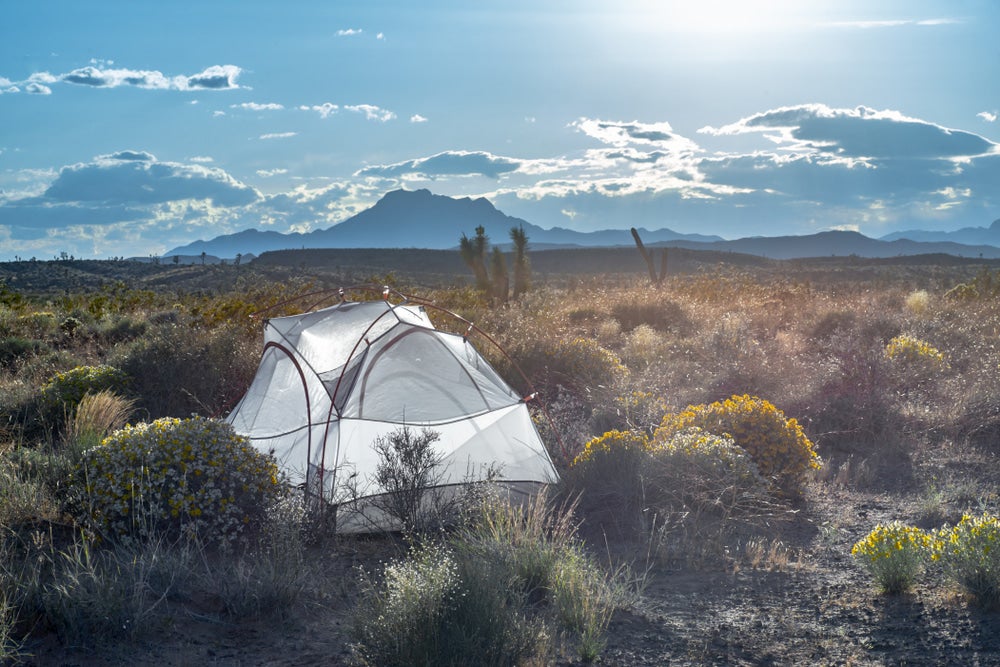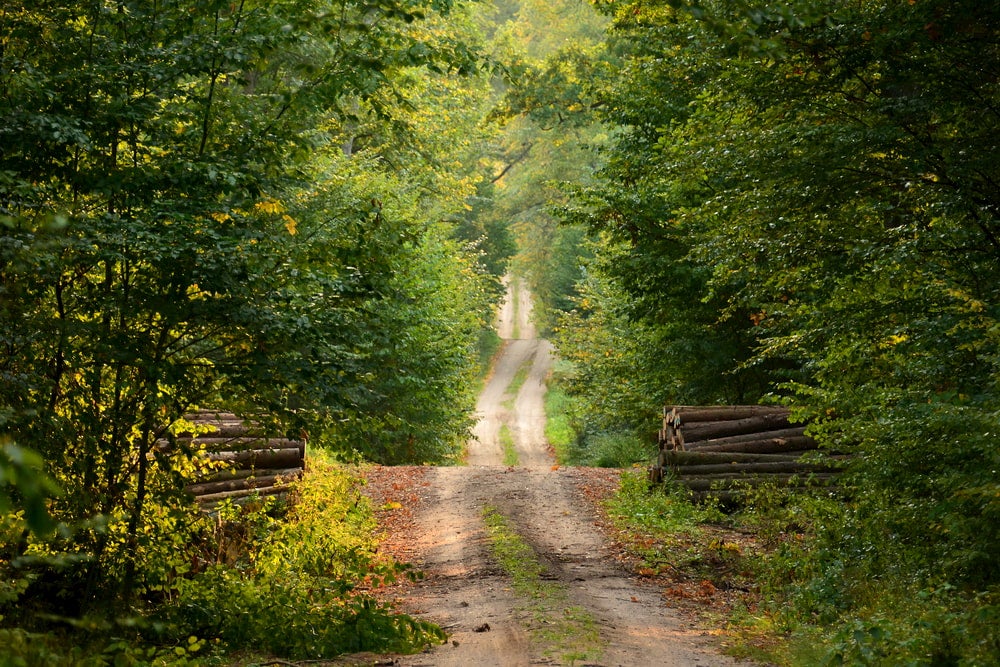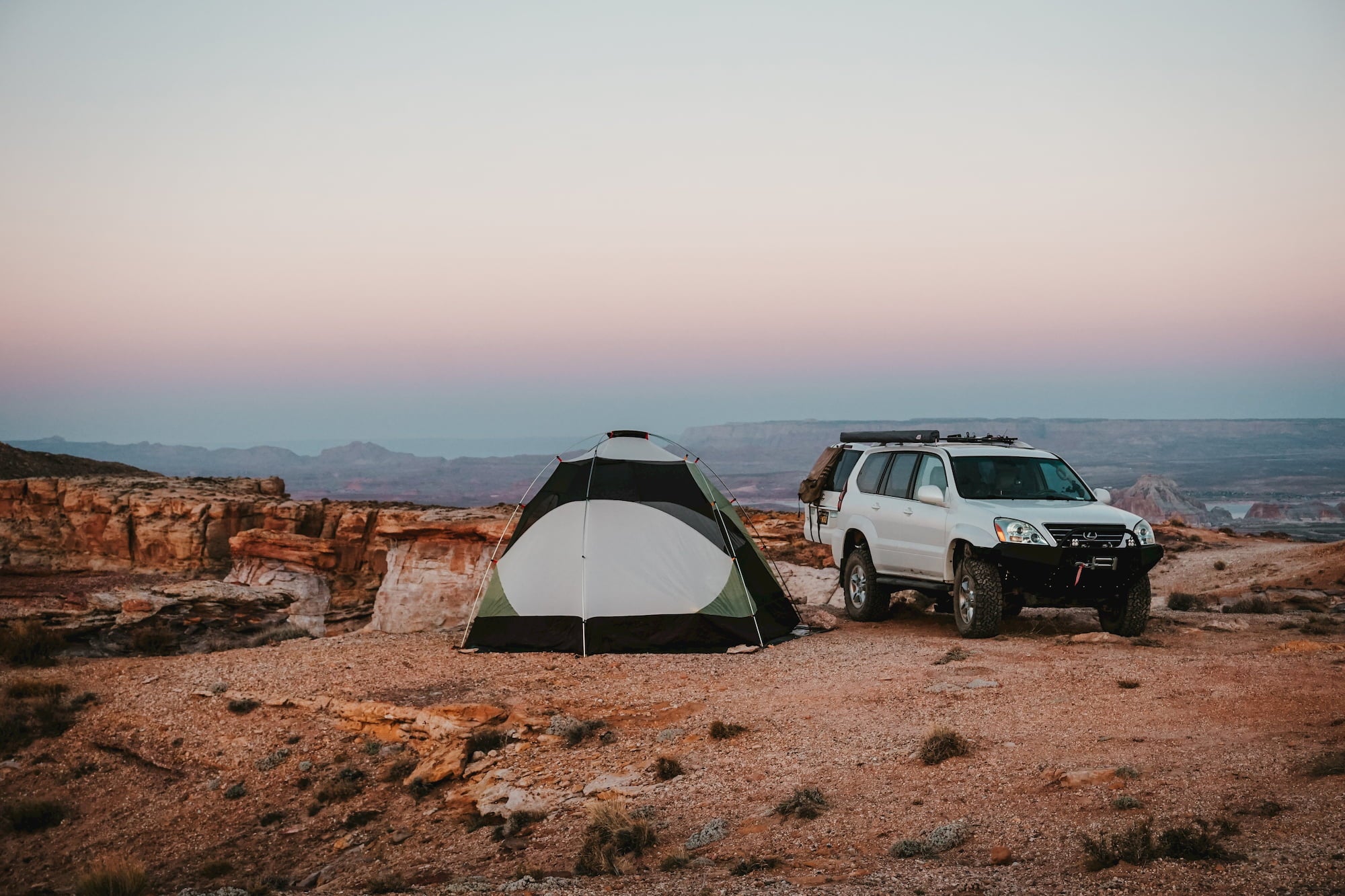It wasn’t the first time I went looking for a campsite an hour before sunset—I like the thrill of last minute camping. It reminds me that after spending too much time hunched over my computer, I can still get out into the wilderness without much planning. Admittedly, what I was trying to do on this particular night—find an available campsite near Yellowstone National Park sans reservation—doesn’t seem like a recipe for success.
However, I was confident that by dispersed camping, I could find a secluded spot—one that people who pack into the parks reservable campgrounds could only imagine. So, what is dispersed camping, how does it work, and why isn’t everyone doing it?
What is Dispersed Camping?

When defining dispersed camping, it helps to first address what it is not. Dispersed camping is not about having amenities. It doesn’t involve a camp host or reservations, and it’s unlikely that you’ll see other campers.
Essentially, “dispersed camping” is camping outside of a designated campground. This can mean driving up a forest access road to a pullout where you can park your small RV. I can also mean backpacking into the mountains and finding a flat spot to pitch your tent. Dispersed camping is best way to find free camping.
If you don’t have a reservation, want to escape campground fees, and don’t mind roughing it, the dispersed camping experience provides the wilderness without campground reservations.
How to Prepare for Dispersed Camping
Dispersed camping quickly became my favorite way to camp, specifically because it involves less preparation. I don’t have to scour recreation.gov for reservations, pay various fees to hold my spot, call around to campgrounds first thing in the morning to ask about availability. I don’t even need to know the exact dates I want to come and go.
While the scheduling logistics might take less planning, there are other factors. Things that don’t come up at established campgrounds. It’s important to be prepared both from a safety and comfort standpoint.
Where Can You Find Dispersed Campsites?

Dispersed camping allows for flexibility in terms of where you set up shop, but it doesn’t mean you can camp anywhere you please. Your first stop (or call) should always be a ranger station to get accurate information on where dispersed camping is allowed.
Dispersed camping typically does not require special permits, but you should double-check with a ranger and ask about any special regulations for the area. Some wilderness areas may require a simple registration at a trailhead. Some forests may have open fire restrictions. Bottom line: know before you go.
Dispersed camping can also be found in public lands like BLM and National Forest Land. These areas do not offer designated sites but you can usually find ideal spots where people have camped before by the marking of a fire pit. You can find free camping even when you’re offline by using The Dyrt PRO. In the PRO version, you can turn on PRO map layers to show where you can disperse camp for free as well as use offline maps to see these areas without service.
Want an adventure of your own? Find free camping near you
Did you know that almost all states in the US have free camping?
Although, some of it is not-so-great and can be hard to find.
There is an easier way:
- Hand-picked free campsites
- Pre-saved to your phone
- The best in all 50 states
It’s the only hand-picked list of 5,000 free camping locations that you will find anywhere.
It comes with a bunch of other features like last-minute camping texts, offline maps, etc.
You can check it out for free today by starting a free 7-day trial. After the 7-day trial, the membership is just $35.99 for a full year of access — well worth it if you camp more than 2 times per year.
What is Dispersed Camping Like at National Park Service Sites?
National Park Service lands typically have greater camping restrictions to protect resources. Some national monuments, national recreation areas, and national parks may allow dispersed camping in certain areas, but you need to ask the park’s permit office before making any assumptions.
Yellowstone National Park, where I found myself on a last-minute adventure, only allows camping at designated campgrounds, whether at one of their drive-in sites or a backcountry site. The established campgrounds can fill up fast, but you just can’t camp anywhere. If you try, you’re going to have an uncomfortable conversation with a ranger if you try to pitch your tent in that awesome meadow you found.
National parks are often close to U.S. Forest Service or Bureau of Land Management areas (also known as BLM land). These public lands are ripe with dispersed camping opportunities. On U.S. Forest Service lands, which may include national forests or national grasslands, dispersed camping is allowed unless otherwise noted.
It is typically not allowed within a mile of developed recreation areas, such as campgrounds, picnic areas, and trailheads. This is why we headed out of Yellowstone National Park’s West Yellowstone entrance toward Custer Gallatin National Forest with an hour to spare before sunset.
Finding Dispersed Camping on Forest Service Lands

What is dispersed camping like on forest service lands? It looks different everywhere you go. For me, it usually means finding a dirt or gravel forest service road. Then driving until I find a wide spot in the road where I can pull over and set up camp.
These sites are often very remote with no services available. You may be right off of a “road,” but it feels like the backcountry.
However, some dispersed camping in national forests can be reminiscent of established campgrounds. After driving up Forest Access Road 167 in Custer Gallatin National Forest, we found ourselves at Cherry Creek Campground. This campground was essentially an access road with a handful of bear lockers and fire pits placed at wide spots in the road and a pit toilet at the very end.
Campers could pitch a tent wherever they found a good spot and stay for up to 16 days fee-free. After 16 days, campers must move at least five miles to another dispersed camping area and cannot return to the same campsite within the calendar year. It was perfect for a last-minute spot to rest our heads close to the national park. It was also beautiful, located alongside Hebgen Lake, and the sounds of singing coyotes and roosting geese lulled us to sleep.
More Tips for Finding Dispersed Camping
I use a National Geographic Road Atlas to find forest access roads, as cell phone service is often spotty in these locations. Be aware that not all forest access roads show up on Google maps. Before my service drops I also look at a satellite image of the area on Google maps, to identify potential clearings in forests and pull-outs along roads. Other than that, I embrace a sense of adventure and flexibility.
In addition to U.S. Forest Service or Bureau of Land Management sites, some city, county, and state parks may offer dispersed camping opportunities. Your best bet for finding new dispersed camping locations is always to call a ranger station.
It’s also easy to find dispersed camping on The Dyrt! Start by entering the state in the search bar, then press enter. From there, click on ‘Filters,’ select ‘dispersed,’ and then click ‘apply.’ You’ll get a handy map view of sites, plus each listing includes information like ratings, reviews, features, and more.
What to Bring When Dispersed Camping

Dispersed camping offers little to no services for campers—often you won’t even find potable water. Plan to pack in everything you’ll need during your stay, and be prepared to pack it all out as well, including your trash. Items to bring include:
- Printed maps in case you don’t have cell phone reception
- A gallon per person per day of water and a backup water filtration system
- Food to last the duration of your stay
- Bear canisters or odor-proof bags for proper food storage if camping in bear country without access to bear lockers
- A container to store your garbage, as dispersed camping sites do not have trash cans
- Safety items, which could include a whistle, compass, flashlight, knife, tire repair kit, and extra layers for warmth
- Tent, sleeping pad, and sleeping bag if you’re not RVing
- Anything else you need to be fully self-sufficient
Leave No Trace While Dispersed Camping

So, what is dispersed camping exactly? An opportunity to connect deeply with nature. It’s a way to feel like you’re deep in the backcountry even when you’re car camping.
Ultimately it’s a chance to experience wilderness up close. However, dispersed camping can only stay this way if we all participate in Leave No Trace.
Leave No Trace principles are a set of guidelines to help outdoor recreationists keep our wilderness wild. These principles limit human impact on the landscape, wildlife, and resources we love. Following LNT principles is vital to keeping the magic of dispersed camping alive. It is much more fun to show up to a remote site and feel truly disconnected than it is to arrive and find someone’s leftover Clif bar wrapper and trampled wildflowers.
Learn and abide by all seven of the Leave No Trace principles, but when dispersed camping, these three are particularly important.
Dispose of Waste Properly
Dispersed camping doesn’t usually include outhouses. Campers will need to plan to go to the bathroom outside. Proper disposal of human waste keeps harmful microorganisms out of the water supply.
To dispose of feces, campers can use a “wag bag” or dig a cathole six inches deep and at least 100 feet away from any water source. Once done, fill the hole back up with dirt and pack out any toilet paper.
Along with your toilet paper, pack out any food wrappers, orange peels, broken gear, or other trash you produce during your stay. Dispersed camping areas typically do not have garbage cans and trash collection services, so keep your own trash bag and dispose of your waste properly once back in civilization.
Minimize Campfire Impacts
Wildfires are a serious threat to our public lands and surrounding communities. Don’t let a spark from your campfire start the next one.
Before starting a campfire, know if there are fire restrictions in effect. Next, decide whether you really need one. Can you cook dinner on an enclosed stove instead?
If you do start a campfire, use existing fire rings to minimize scarring new rocks, soil, and plants. Bring approved firewood with you, or use only dead and downed wood from around your campsite. Before you leave your campfire, make sure it is cool to the touch and stir the ashes to make sure all embers are out.
Travel & Camp on Durable Surfaces
When heading off to find some “bathroom” privacy, be mindful of where you step. Travel on durable surfaces and do not trample vegetation. When otherwise traveling around your campsite, use existing trails whenever possible. What is dispersed camping doing to the land?
Hopefully, causing less impact than established campgrounds—but only if we camp responsibly.
Set up camp at least 100 feet away from any stream. Try to pick a site away from large clearings, so if other campers are in the area, they’ll still get wilderness views. Do not drive on meadows to access a camping site; stay on existing roads to avoid resource damage. If you’re camping in an area where others have before, choose a previously-used site to minimize new impacts on plants, soil, and wildlife.
You should also camp on bare soil or gravel when possible to avoid damaging plants and grasses. Look for a site that is already flat; do not dig or otherwise try to level the ground to create a site. By traveling and camping on durable surfaces, campers can help keep the wild feeling of dispersed camping alive.
Related Articles:
- Boondocking: A Guide to Free RV Camping
- Quartzsite, AZ
- Custer State Park
- Off Road Campers
- Backpacking Checklist
- Walmart Camping



